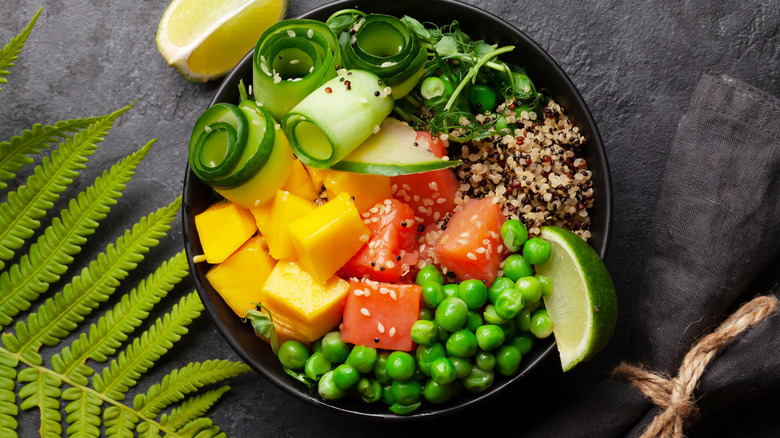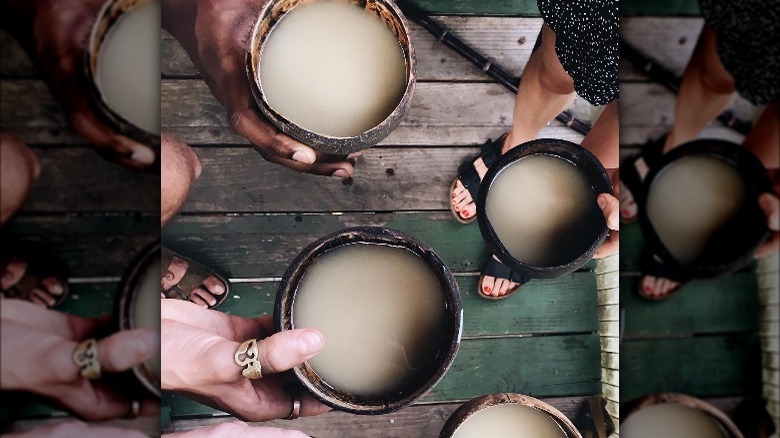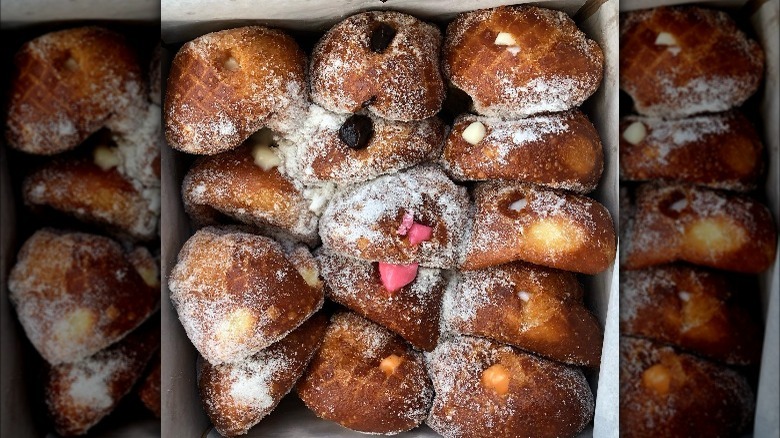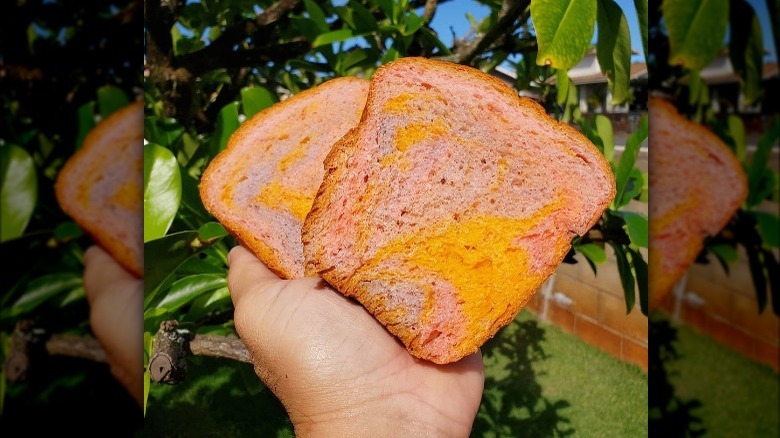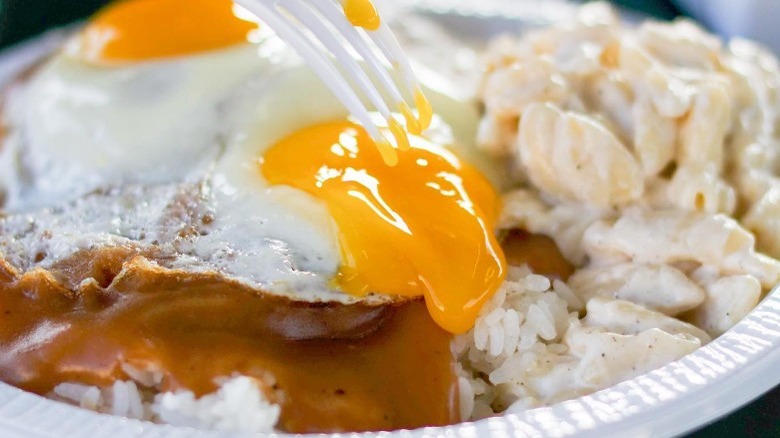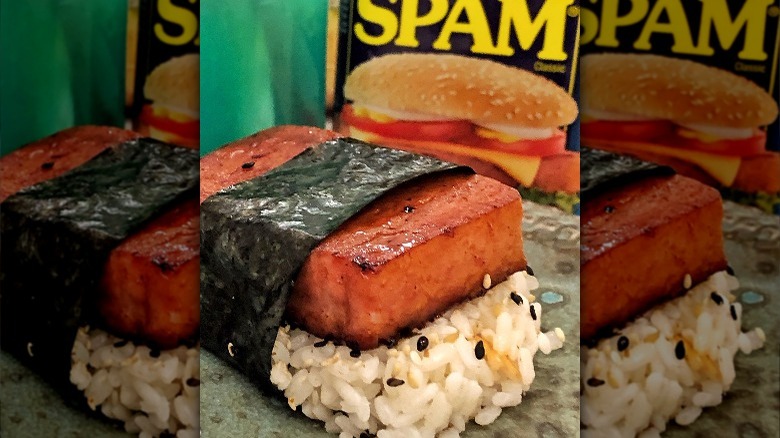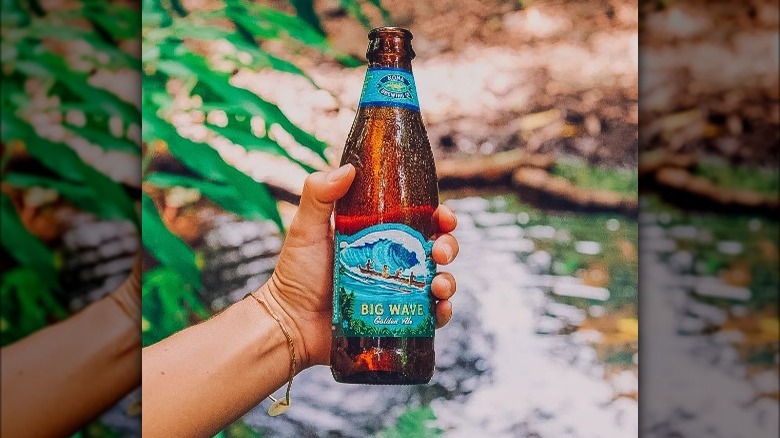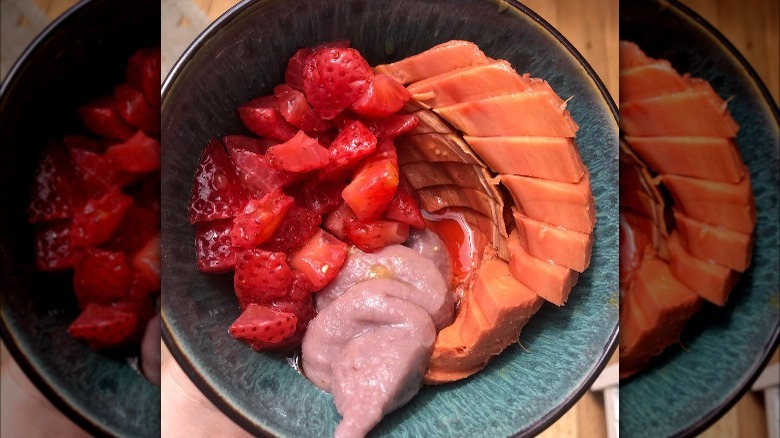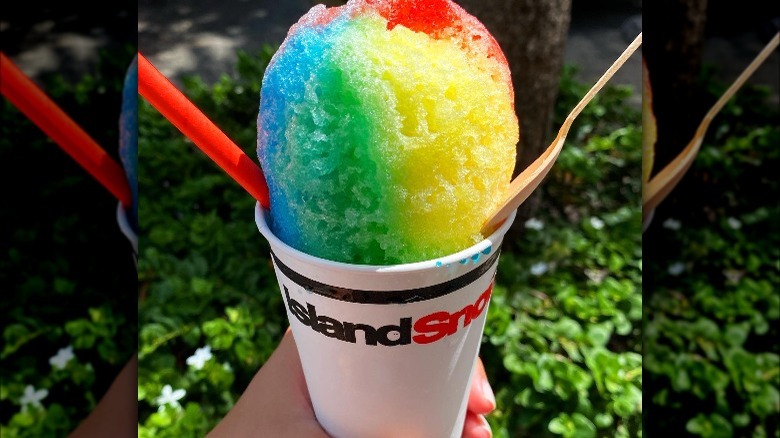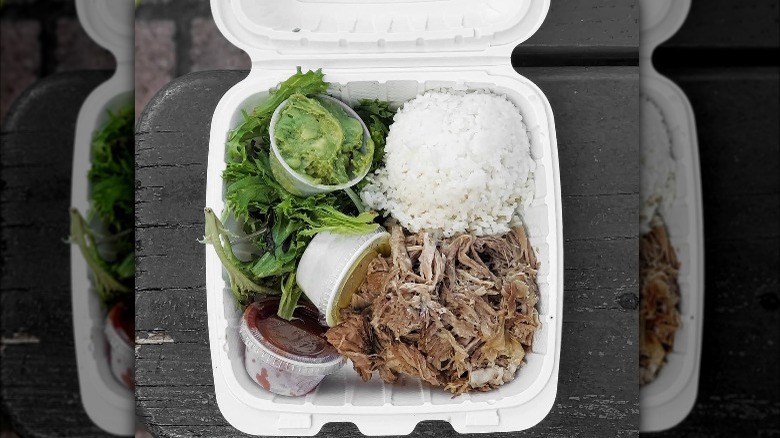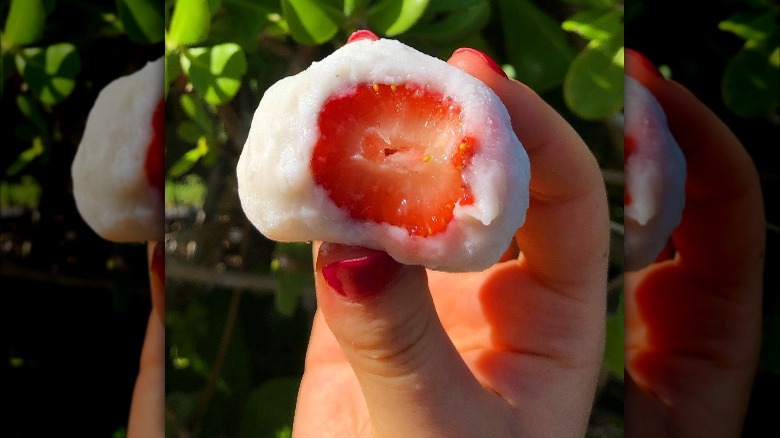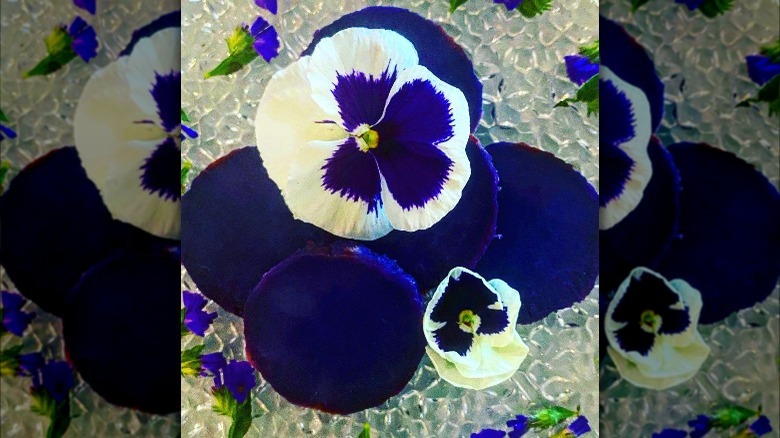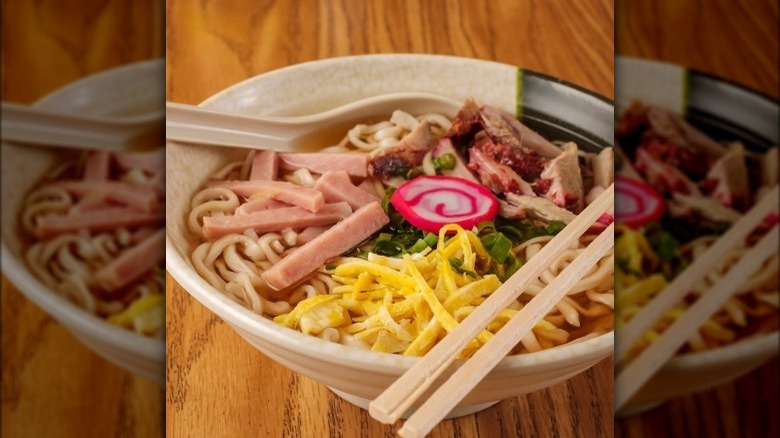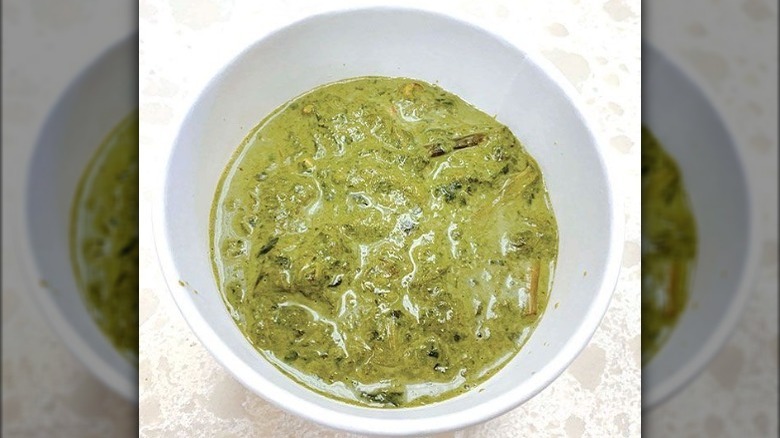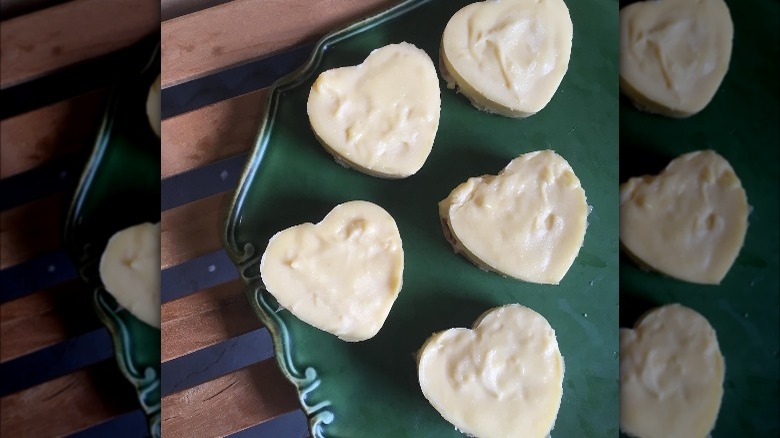The Best Hawaiian Foods You Probably Haven't Tried Yet
Hawaii is for many synonymous with rainbows, sandy beaches, flowers, cocktails, and a state of euphoric relaxation. Though Hawaiian cuisine might be for many a second thought, there's no denying the grip that island delights like poké (which are easier to make than you might think) have had on U.S. cuisine over the last couple of years. Those colorful bowls filled with cuts of raw seasoned fish, usually topped with a bevy of goodies have ultimately migrated down to the continental U.S. and across the globe with no signs of stopping (via EHL Insights).
It seems that these yummy bowls have become one and the same with the idea of Hawaiian food. Well, that and maybe Hawaiian pizza, which isn't really North American much less Hawaiian. Don't get it twisted, while poké is an amazing dish, the islands have so much more to offer! A multicultural hub with a long history and plenty of room for fresh produce and catches, there's much to explore and get to know.
Kava
First up is kava. To those unfamiliar with the drink, its color might be a little off-putting. It looks more like muddy water than anything meant to be enjoyed. But, there is something beyond that old saying of not judging a book by its cover.
Kava is a root drink and made from the Piper methysticum, a plant that is native to most of Oceania and has a large role in oceanic culture. Kava comes from the Polynesian word "kawa" which means bitter, of course referring to the drink's less than sweet taste. Kava, similar to other bitter brews is meant to be sipped on slowly!
So bitter water that looks like it's been infused with clay? Why on Earth would anyone drink this? Well, kava has a natural numbing effect, that has been said to relieve stress and anxiety (via WebMD). Traditionally kava would be served at special ceremonies and sharing a bowl of kava has had a very special social connotation in Hawaiian culture for a long time.
Kava still persists as a social drink, and it's not uncommon to pour kava into a halved coconut shell from a large wooden bowl and kick back with a few friends.
Malasadas
Not many people know about the Portuguese influence on Hawaiian cuisine, but it's at its most apparent in malasadas, a small and sweet fried dough. But how did these Portuguese delicacies make it to the middle of the Pacific Ocean? In the 19th century, Portuguese laborers came to Hawaii to work on plantations and with them came their culinary traditions (via Mic).
Malasadas always come coated in sugar, sometimes even in a mouthwatering cinnamon-sugar blend. According to Eater, the word malasada roughly translates to "poorly cooked," which probably refers to the snack's crispy exterior and soft and doughy interior. Hawaiian malasadas are unique from traditional Portuguese malasadas in that they are smaller, round with little aroma and mild taste (via Eater). Today, more experimental malasadas can also be found in an array of flavors. At bakeries like Leonard's in Oahu, there are malasada puffs that are filled with other island delights like mango, haupia, and guava. No matter the flavor, malasadas make a great snack on the go or companion to a bold cup of coffee.
Hawaiian sweet bread
Another grain-based treat, Hawaiian sweet bread surely takes the cake. Perhaps when talking about fluffy bread from the island, the first thing that comes to mind is the brand King's Hawaiian, a staple among many grocery stores. But, there's more to know about this traditional baked good!
Hawaiian sweet bread is somewhere in the crosswinds, a sort of fusion between Filipino, Portuguese, and Hawaiian cuisine (via Taste). Sweet bread is a mellow treat: a fluffy light bread with, of course, a notably sweet taste. While there are many different sweet bread recipes, there's a consensus that Hawaiian sweet bread should be made from sugar, honey, yeast, etc. with a slight citrus twist (via Big Island Guide). You can find sweet bread served with breakfast, at luaus, or as a sandwich.
If you're looking to try sweet bread baked right in Hawaii, the Punalu'u Bake Shop offers express shipping of their sweet breads, available in traditional, guava, and taro among other flavors.
Loco moco
Loco moco is a local grind: a completely Hawaiian quick bite. It is a no thrills dish, a hamburger patty on rice topped with egg, doused in gravy, and finished with green onions. What really defines the dish's flavor is the onion. With both green and sautéed onions, this savory dish is paired best with a cup of fresh black coffee (or a good beer). It is, to put it mildly, a comfort food.
According to What's Cooking America, Loco Moco was first conceived after World War II to satisfy hungry teenagers who were looking for a less time-intensive breakfast. This isn't to say that loco moco is exclusive to breakfast, this heavy hitter of a dish can be enjoyed at just about any part of the day. Though maybe be prepared for the food coma that comes after.
If you're looking to bring some Island flavor into your own kitchen, check out Onolicious Hawai'i which offers a nice recipe guide to this simple dish. As the blogger advises in their recipe, "In the end, loco moco should be a fun and low-stress situation. Just go home, cook rice. Fry a burger patty. Make gravy. Fry an egg. Layer it all together."
Spam musubi
Another savory classic and (indirect) result of the World Wars is spam musubi. Spam was first introduced to the Islands in the 1940s with the arrival of the soldiers. It wasn't long before spam became an island staple; currently, over 5 million pounds of spam are consumed annually in Hawaii (via National Geographic). This is pretty impressive given how small the islands are. Hawaiian-born chef Mark "Gooch" Noguchi, attributes the staying power of Spam to the tenacity, creativity, and beauty of Hawaiian cuisine (via Vice).
Spam musubi is one such example. Musubi is another popular Hawaiian food that is similar to the Japanese onigri: packed white rice and protein wrapped together with a band of seaweed (via L&L Hawaiian BBQ). More often than not Spam and musubi go together hand-in-hand.
It's not as simple as popping open a can of spam wrapping it up nicely, though, for the love of simplicity, it's not much more difficult than that. The chef who was praised as "embodying Hawai'i's past, present, and future", Chef Sheldon Simeon, suggests a down-home Spam musubi with a few tips and tricks. The most important step? He suggests grilling the Spam and glazing it with a nice soy and sugar sauce to add an extra level to this classic dish (via the Washington Post).
Kona Brewing Co. beer
Beer might not be the first thing that comes to mind when talking about Hawaiian cuisine. But the nearly 30-year-old Kona Brewing Company is a way to enjoy a taste of Hawaii. The once-small brewery isn't afraid of exploring the islands through its different brews that utilize local flavors. Notes of pineapple, mango, guava, a rare honey, and Kona coffee are only some of their regional flavor (via Eater). Kona Brewing Company creates a tasty micro-brew with a decidedly Hawaiian approach.
The packaging is another aspect of the beer; Kona Brews are served in simply pretty bottles. Each bottle is wrapped with a label that is as one-of-a-kind as the drink it carries.
It's possible to drink Kona beers outside of Hawaii, and the brewing company is one of the fastest-growing breweries at the moment. Keep in mind if you're drinking in the lower 48, however, the beer has most likely been brewed outside the islands (via Eater). Yep, to truly enjoy the Hawaiian-born beer, you'll need to actually visit Hawaii.
Poi
Poi is a uniquely Hawaiian food, in fact, there's a spiritual element to the dish. Poi is said to be made from Haloa, a descendant of the sky god and according to legend, the first Hawaiian. This dish has been a major part of Hawaiian culture, literally, since the beginning.
Made by mashing taro root and then diluting it to the heart's delight, this traditional side has a creamy lavender complexion. There is no one consistency to poi, but rather a system. Poi is made with the "finger" method: "one finger," "two fingers," or "three fingers," depending on how many fingers are needed to scoop it (via Luaus).
Poi is a relatively mild treat, it's not going to be the most flavorful thing on the table. When it is served though, it will be served one of two ways: sweet or sour (via the Culture Trip). Sweet poi is freshly made poi, that is usually topped with honey or sugar to sweeten it up a bit more. Sour poi, on the other hand, is left to ferment for a few days and has a fair amount of vitamins. It pairs nicely with meats and other savory dishes. Whether sweet or sour this is a dish that delights.
Hawaiian shave ice
Is there really any better place to enjoy an icy treat? Only Hawaii could take something as simple as shaved ice and turn it into a syrupy sweet confection in the most vibrant of colors. In an interview with the New York Times, one Hawaiian-born food historian went to investigate the origins of shave ice and found the dessert to have been a result of colonization. Settlers did not want to forgo the comfort of ice on the island, and specifically, Japanese immigrants were accustomed to a very popular ice dessert. By the beginning of the 20th century, shave ice had made its landing.
There's a good reason why this dessert has stuck around as long as it has. Scoops of snowflake-like ice that is powdery light but packed enough to hold flavorful syrup without melting into a disgusting sticky puddle and in just about any flavor imaginable, of course, they've stayed popular! Those who are particularly indulgent go ahead and finish their treats off with red azuki beans or a scoop of ice cream. Or maybe both, life is short after all.
It goes practically without mentioning that one legendary shave ice fan, is no other than Hawaiian-born Barack Obama (via the LA Times). Though Mr. Obama is no longer in office, his legacy remains in more than one way. Go ahead and enjoy one of his favorites, the "Snowbama" a rainbow concoction made out of lemon-lime, cherry, and passion-guava syrup (via the Huffington Post).
Kalua pig
A luau staple, kalua pig (also referred to as kalua pork), is a savory slow-roasted dish that utilizes a traditional style of cooking to achieve a one-of-a-kind flavor. Kalua refers to the method used to cook the pig. Traditionally the entire pig is cooked when making kalua pig. The pig is cooked underground, in a hand-dug pit. The pit's bonfire uses porous lava rocks to make for a breezier fire (via the Culture Trip). The pig is then covered in banana and ti leaves to season and a few inches of dirt are added to seal in the heat (via Onolicious Hawaii).
The effect? Slow steam that leaves the pork so tender it just falls off the bone. The pig is then shredded, seasoned, and served. It's more often than not accompanied by a few other sides, like the previously mentioned poi. For barbecue aficionados, Hawaii might be an unexpected trip but it's certainly a worthwhile trip to take.
Mochi
There is no clearer example of Hawaiian and Japanese fusion cuisine than the beloved mochi treat. This traditional Japanese rice-dessert can be found all around the islands and even served as a festive treat on Girls' Day, another stateside Japanese tradition. The Girls' Day mochi, is a small three-layered confection with pink, white, and green layers: pink to symbolize energy and new blossoms, white to symbolize purity and green to symbolize young leaves, energy, and family (via Hawaii Magazine).
There are things that make mochi in Hawaii unique though, like the flavors it can be found in. Taro, liliko'i, and guava are all sweet confections that pair nicely with their surroundings. Butter mochi, also unique to Hawaii, makes a bold footprint in the dessert scene. Its rich combination of butter and coconut milk makes for an unmistakable tropical variant of mochi (via Contemplating Sweets).
In the ever-shifting food landscape, the only thing to ever be counted on is change. If looking for a more modern plant-based take on Hawaiian butter mochi, why not try a 'ulu-spice vegan butter mochi (via Honolulu Magazine)?
Purple sweet potato
Sweet potatoes are a hyper-trendy food that can be cooked in any number of ways from fries to pancakes. When talking about sweet potatoes a bright orange is probably among the first thing that comes to mind. In the seemingly infinite potato family, there are many different ways to have a sweet treat; like say a purple sweet potato. Also known as Okinawan sweet potatoes, this once imported potato has flourished in the soils of Hawaii (and in Hawaiian cuisine) for a very long time.
Purple sweet potatoes have the same antioxidants that make raspberries, blackberries, and eggplants among fruits and vegetables their vibrant and deep shade (via Hawaii Ocean Project). The particular main antioxidant in Okinawan sweet potatoes is anthocyanin, which according to one study, combats inflammation, boosts cancer defense, and is antibacterial. WebMD reports that one purple sweet potato has about three times as many anthocyanins as a blueberry. Maybe this is the secret to the famed longevity of the Okinawans.
Okinawan sweet potatoes are a bit sweeter and more complex in flavor than their orange cousins. They're just as versatile though, and can be found in any number of ways on the table; from mashed to baked into a sweet dessert.
Saimin
A melting pot all in a soup bowl, saimin represents the complexity of the contemporary Hawaiian food identity. The name saimin actually originates from Chinese and roughly translates to "thin noodles" (via Hawai'i Magazine). This is a good clue as to what makes this dish distinctive from other panasian noodle dishes: its unique noodles! Saimin noodles are somewhat similar to ramen noodles but thinner, darker, and bolder in flavor. The noodles are then, as described by Hawaii magazine, served in a clear shrimp-based broth and garnished with char siu (a Chinese bbq pork), slices of spam, kamaboko (a Japanese fish cake), and egg. This is, simply put, not a light dish.
Saimin has persisted throughout the years and can be found just about in any sort of dining setting dressed as up or down as need be; Hawai'i-based McDonalds have gone so far as to include it on the menu. Beyond the Golden Arches, saimin has earned accolades from prestigious American culinary awards to a positive, if not vulgar, review from the heralded Anthony Bourdain. When asked where saimin falls in larger noodle food trends the previously mentioned chef Noguchi declared, "Ramen is trendy, saimin is life."
Squid luau
Of course, a large part of Hawaiian cuisine is seafood. While seafood is usually served cooked or raw, squid luau is an interesting exception. It's a heavier stew-like dish, that is as filling as it looks.
One would think that to have squid luau, you need, well ... squid. While traditionally prepared with squid, but often tako (octopus) and other meats are substituted for squid. No matter the protein, Hawai'i Magazine argues that is imperative to prepare the dish with taro leaves and coconut milk. This chilled thick soup dish may not be the main attraction at a luau, but is a welcome side (via Onolicious Hawaii). At first glance, squid luau might look like an off-putting purée. Those willing to dig in and chow down are nonetheless in for a real hearty treat.
In one generously shared family recipe, the chef notes that stewing the ingredients together is what really gives squid luau an amazing flavor that is simultaneously salty, sweet, and creamy. Another tip she divulges? When cooking squid luau, boil taro leaves with a bit of baking soda. It will help the leaves retain their green color.
Haupia
A sweet finish to the article, haupia is a quintessentially Hawai'ian coconut dessert. Haupia sort of exists between extremes, it should not be too soft yet not too firm (via Hawai'i Magazine). Making haupia is not a complex undertaking. The dish only consists of four ingredients: coconut milk, sugar, cornstarch, and water. It takes only around 15 minutes to make and two hours to cool (via Fav Family Recipes). This pudding-Jell-o-like snack is a bold white color, always served chilled and often cut into small rectangles or as a custard when on the table.
Onolicious Hawaii mentions that it's not uncommon to find haupia served alongside savory dishes. While haupia is not meant to be eaten with say, squid luau, it can act as a very sweet palate cleanser. It is maybe haupia's mild sweetness that makes it so versatile among desserts, in fact, it pairs very nicely with the previously mentioned sweet potato. Haupia can be found as a sort of meringue to chocolate pies, served fried at McDonald's, and even as gourmet ice cream. Any way you slice it, the eating is good.
